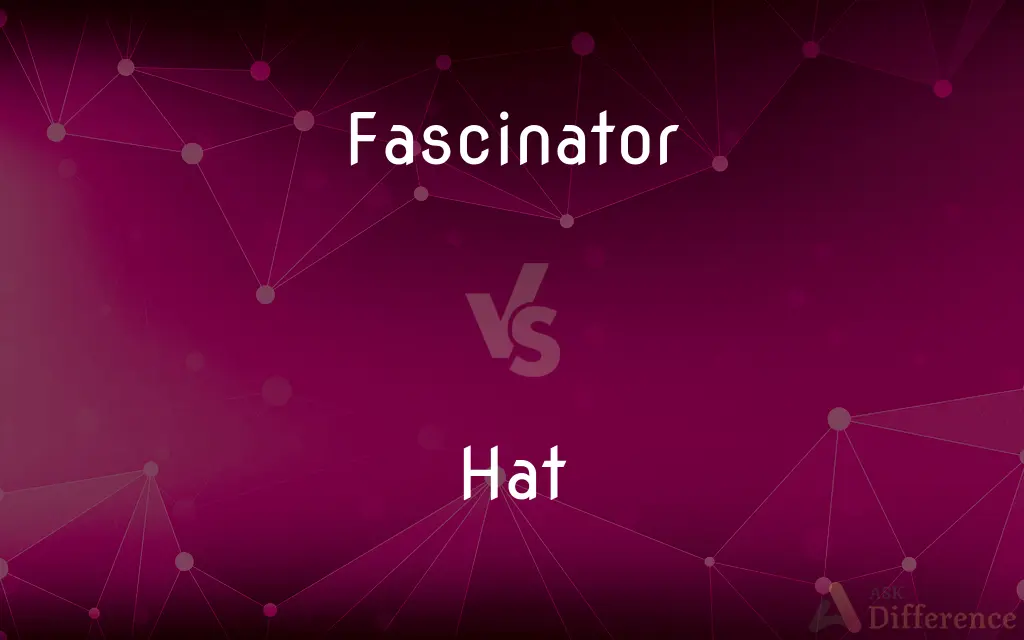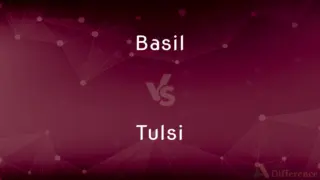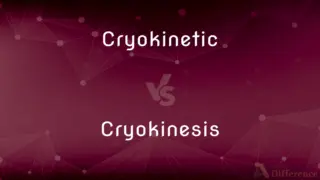Fascinator vs. Hat — What's the Difference?
Edited by Tayyaba Rehman — By Fiza Rafique — Updated on March 20, 2024
Fascinators are ornate, lightweight headpieces, often with feathers or beads, while hats cover the head more fully and are practical.

Difference Between Fascinator and Hat
Table of Contents
ADVERTISEMENT
Key Differences
Fascinators are decorative headpieces that are typically smaller and lighter than hats. They are often designed with feathers, beads, or flowers and are attached to the head with a clip or a headband. Hats, on the other hand, are designed to cover the entire head and come in various shapes and sizes, serving both practical and fashion purposes.
While fascinators are largely worn as a fashion statement, especially at formal events like weddings or horse races, hats can be worn for practical reasons, such as protection from the weather, in addition to their fashion appeal. Fascinators, whereas, are not typically used for protection against elements like sun or cold.
Fascinators are known for their artistic and elaborate designs that make them stand out as statement pieces at formal events. Hats, on the other hand, can range from simple, everyday wear to elaborate designs that complement formal attire.
In terms of construction, fascinators might not have a brim or a full crown like traditional hats, and they can be considered more as hair accessories than full head coverings. Hats, whereas, are generally constructed with a full crown and often a brim to provide shade or protection.
Culturally, fascinators have become particularly popular in the United Kingdom and among royalty for special occasions, symbolizing high fashion and elegance. Hats, while also significant in British culture, have a broader usage globally, ranging from casual to formal settings.
ADVERTISEMENT
Comparison Chart
Primary Use
Fashion statement at formal events
Practical head covering and fashion
Design
Ornate, featuring elements like feathers and beads
Wide variety, from simple to elaborate, often with a brim
Coverage
Minimal, more an accessory than a covering
Full head coverage, often with protection against elements
Cultural Significance
Popular in the UK, especially at royal events
Global use, varying from casual to formal occasions
Construction
Lacks a full crown or brim, attached with clips or headbands
Typically includes a full crown and often a brim
Compare with Definitions
Fascinator
Often features feathers, beads, or flowers for adornment.
Her fascinator was adorned with vibrant peacock feathers.
Hat
Worn globally, with specific styles signifying cultural identities.
The cowboy hat has become an icon of American Western culture.
Fascinator
Designed to be lightweight and attached with clips or headbands.
She opted for a lightweight fascinator instead of a heavy hat.
Hat
Designed to cover the entire head.
The hat's wide brim covered her face, protecting her from the harsh wind.
Fascinator
Serves as a bold fashion statement.
Her fascinator turned heads with its unique design.
Hat
Offers protection from sun, cold, or rain.
He wore a wide-brimmed hat to shield himself from the sun.
Fascinator
Commonly worn at weddings and horse racing events.
At the royal wedding, fascinators were the preferred choice among female guests.
Hat
Includes fedoras, baseball caps, and sun hats among others.
She had an extensive collection of hats, from beanies to berets.
Fascinator
Provides minimal head coverage, focusing on style over function.
Despite the sunny day, her fascinator offered little shade.
Hat
Suitable for both casual and formal occasions.
For the outdoor excursion, he chose a comfortable, casual hat.
Fascinator
A fascinator is a formal headpiece, a style of millinery. Since the 1990s the term has referred to a type of formal headwear worn as an alternative to the hat; it is usually a large decorative design attached to a band or clip.
Hat
A hat is a head covering which is worn for various reasons, including protection against weather conditions, ceremonial reasons such as university graduation, religious reasons, safety, or as a fashion accessory.In the past, hats were an indicator of social status. In the military, hats may denote nationality, branch of service, rank or regiment.
Fascinator
One that fascinates.
Hat
A covering for the head, especially one with a shaped crown and brim.
Fascinator
A woman's headscarf.
Hat
A head covering of distinctive color and shape worn as a symbol of office.
Fascinator
A hat or headband lavishly decorated with feathers, flowers, or other adornments and often worn on a slant.
Hat
The office symbolized by the wearing of such a head covering.
Fascinator
A fascinating person or thing.
Hat
A role or office symbolized by or as if by the wearing of different hats
Wears two hats—one as parent and one as corporate executive.
Fascinator
A delicate, often frivolous head decoration worn on the hair, primarily by women
Hat
To supply or cover with a hat.
Fascinator
A type of wool or lace headscarf
Hat
A covering for the head, often in the approximate form of a cone, dome or cylinder closed at its top end, and sometimes having a brim and other decoration.
Hat
(figuratively) A particular role or capacity that a person might fill.
Hat
(figuratively) Any receptacle from which numbers/names are pulled out in a lottery.
Hat
The lottery or draw itself.
We're both in the hat: let's hope we come up against each other.
Hat
(video games) A hat switch.
Hat
The háček symbol.
Hat
The caret symbol ^.
Hat
(internet slang) User rights on a website, such as the right to edit pages others cannot.
Hat
A student who is also the son of a nobleman (and so allowed to wear a hat instead of a mortarboard).
Hat
(transitive) To place a hat on.
Hat
(transitive) To appoint as cardinal.
Hat
(intransitive) To shop for hats.
Hat
Hot.
Hat
A covering for the head; esp., one with a crown and brim, made of various materials, and worn by men or women for protecting the head from the sun or weather, or for ornament.
Hat
Headdress that protects the head from bad weather; has shaped crown and usually a brim
Hat
An informal term for a person's role;
He took off his politician's hat and talked frankly
Hat
Put on or wear a hat;
He was unsuitably hatted
Hat
Furnish with a hat
Common Curiosities
What is the main purpose of wearing a hat?
Hats serve to cover the head, offering protection from elements like the sun or cold, in addition to being a fashion accessory.
What defines a fascinator?
A fascinator is a decorative, lightweight headpiece often worn at formal events, characterized by its elaborate design with feathers or beads.
What types of hats are there?
There are numerous types of hats, including fedoras, baseball caps, sun hats, beanies, and many more, catering to different occasions and needs.
What occasions are fascinators most commonly worn?
Fascinators are popular at weddings, tea parties, and horse racing events, especially in the UK.
Do men wear fascinators?
Fascinators are predominantly worn by women, while men might opt for more traditional hats.
Are there any cultural significances associated with hats?
Yes, certain hats have cultural significances, such as the beret in France or the cowboy hat in the American West.
Are fascinators suitable for casual wear?
Fascinators are generally reserved for more formal occasions and are not typically considered casual wear.
Can a hat be considered a fashion statement?
Yes, hats can also be fashion statements, especially when they feature unique designs or are worn with formal attire.
Can a fascinator replace a hat?
While fascinators can be worn instead of hats for fashion purposes, they don't offer the same level of protection or coverage as hats.
How is a fascinator worn?
Fascinators are attached to the head using clips, headbands, or combs, and are often positioned to one side or atop the head.
Can hats be customized?
Yes, hats can be customized in terms of size, color, and decorative elements to suit individual preferences.
Are fascinators considered formal attire?
Yes, fascinators are generally considered part of formal attire, particularly in British culture.
How has the popularity of fascinators evolved?
Fascinators have seen a resurgence in popularity, especially following their prominent display at high-profile royal events.
Is there a specific season for wearing fascinators?
Fascinators are not season-specific but are more commonly worn during spring and summer events.
How do you choose the right hat for an occasion?
The choice depends on the occasion's formality, the weather, and personal style preferences.
Share Your Discovery

Previous Comparison
Basil vs. Tulsi
Next Comparison
Cryokinetic vs. CryokinesisAuthor Spotlight
Written by
Fiza RafiqueFiza Rafique is a skilled content writer at AskDifference.com, where she meticulously refines and enhances written pieces. Drawing from her vast editorial expertise, Fiza ensures clarity, accuracy, and precision in every article. Passionate about language, she continually seeks to elevate the quality of content for readers worldwide.
Edited by
Tayyaba RehmanTayyaba Rehman is a distinguished writer, currently serving as a primary contributor to askdifference.com. As a researcher in semantics and etymology, Tayyaba's passion for the complexity of languages and their distinctions has found a perfect home on the platform. Tayyaba delves into the intricacies of language, distinguishing between commonly confused words and phrases, thereby providing clarity for readers worldwide.















































